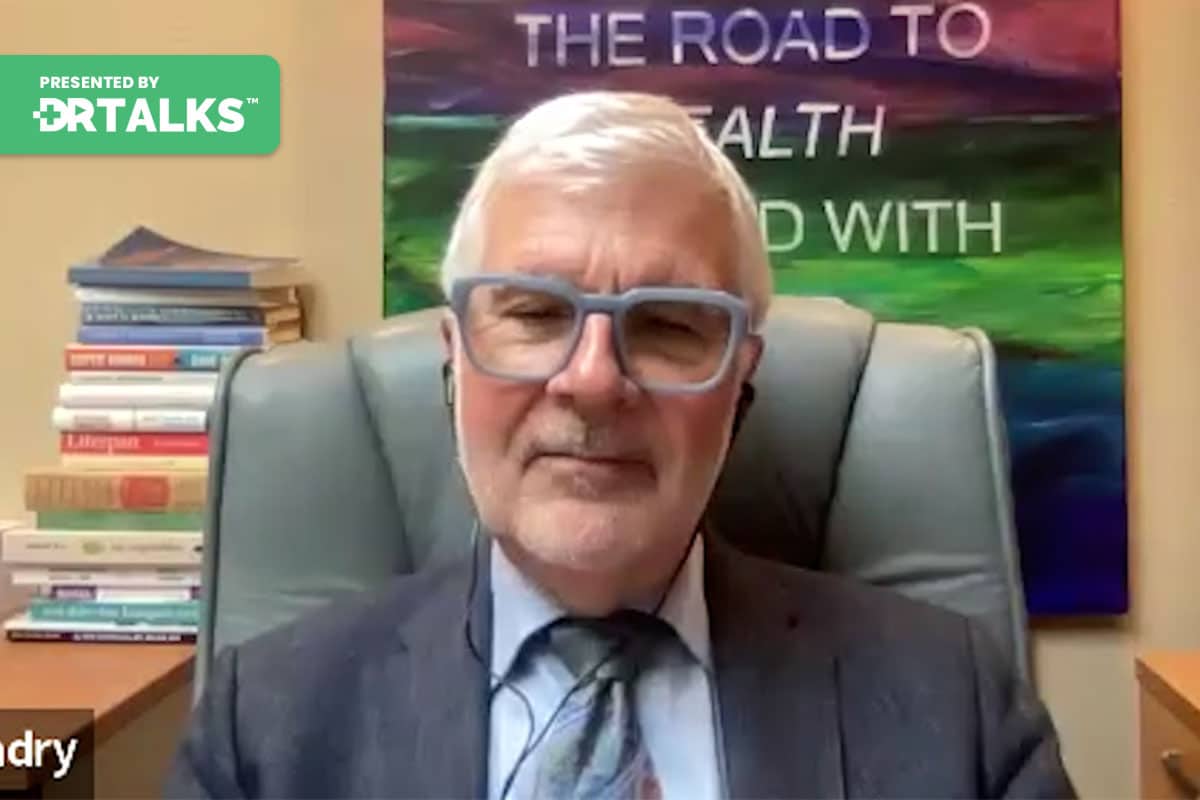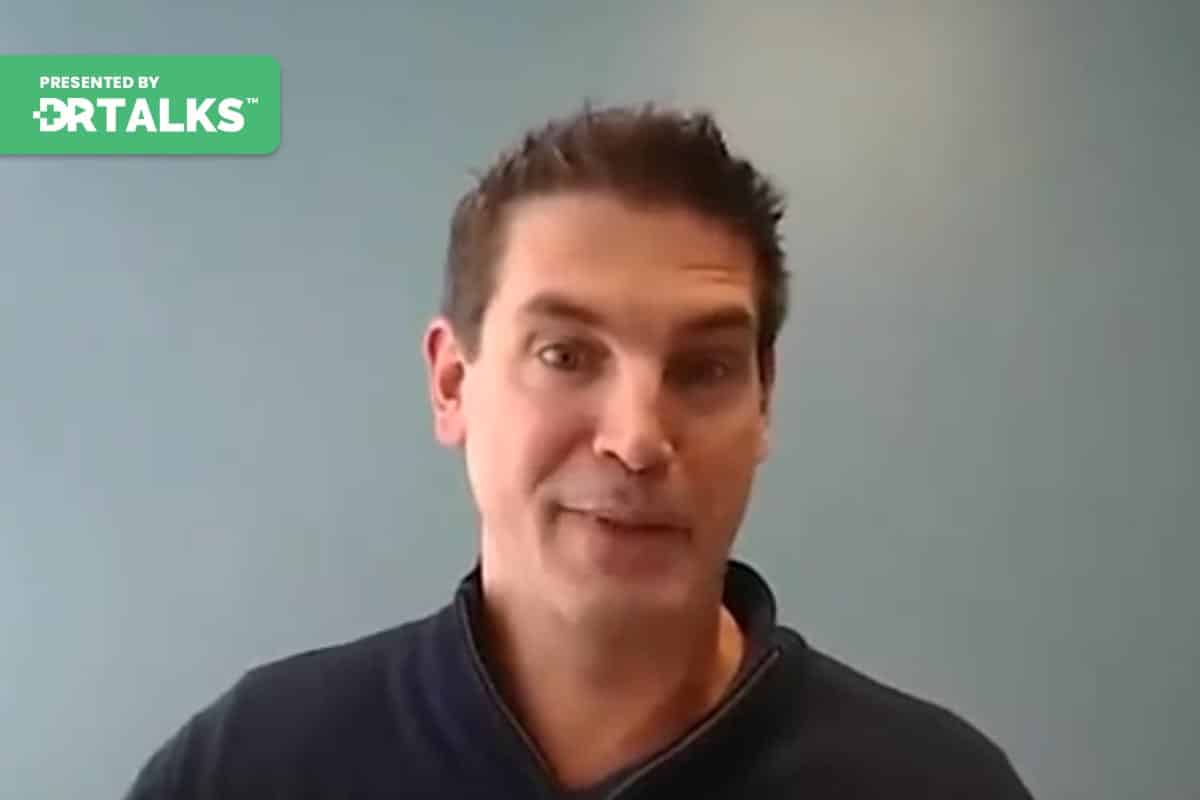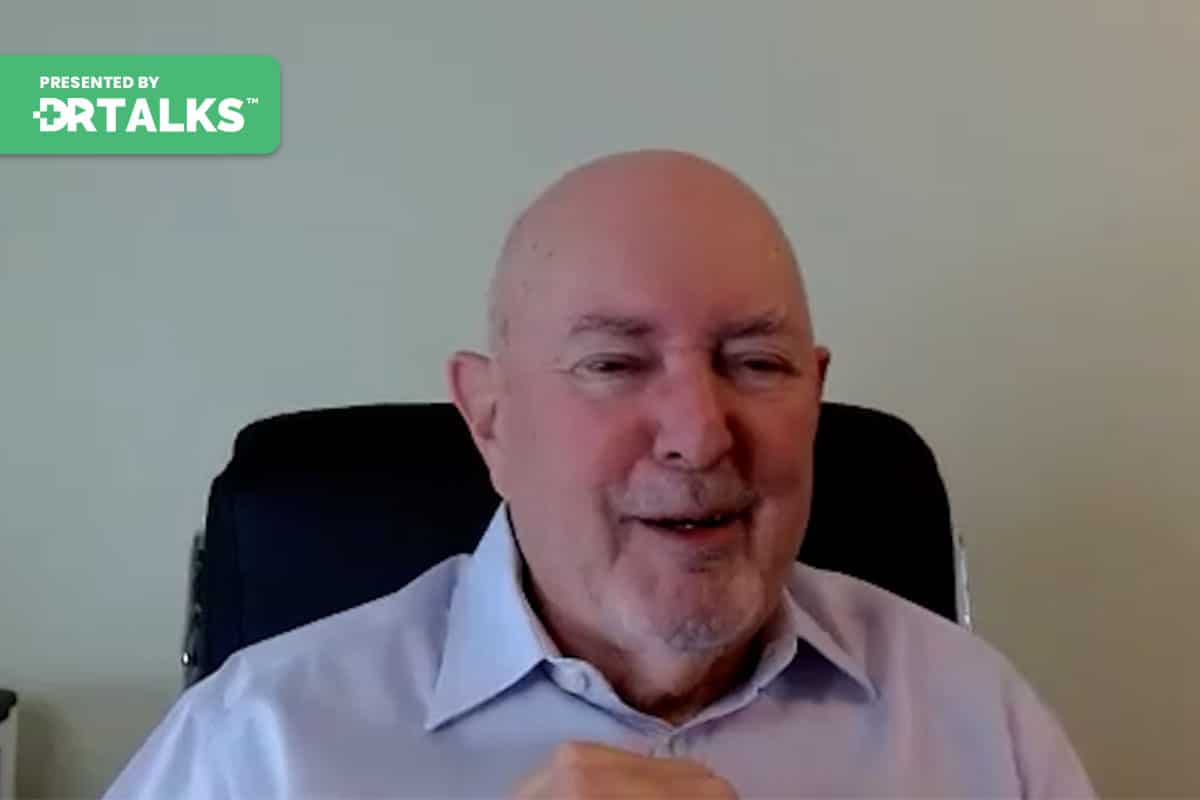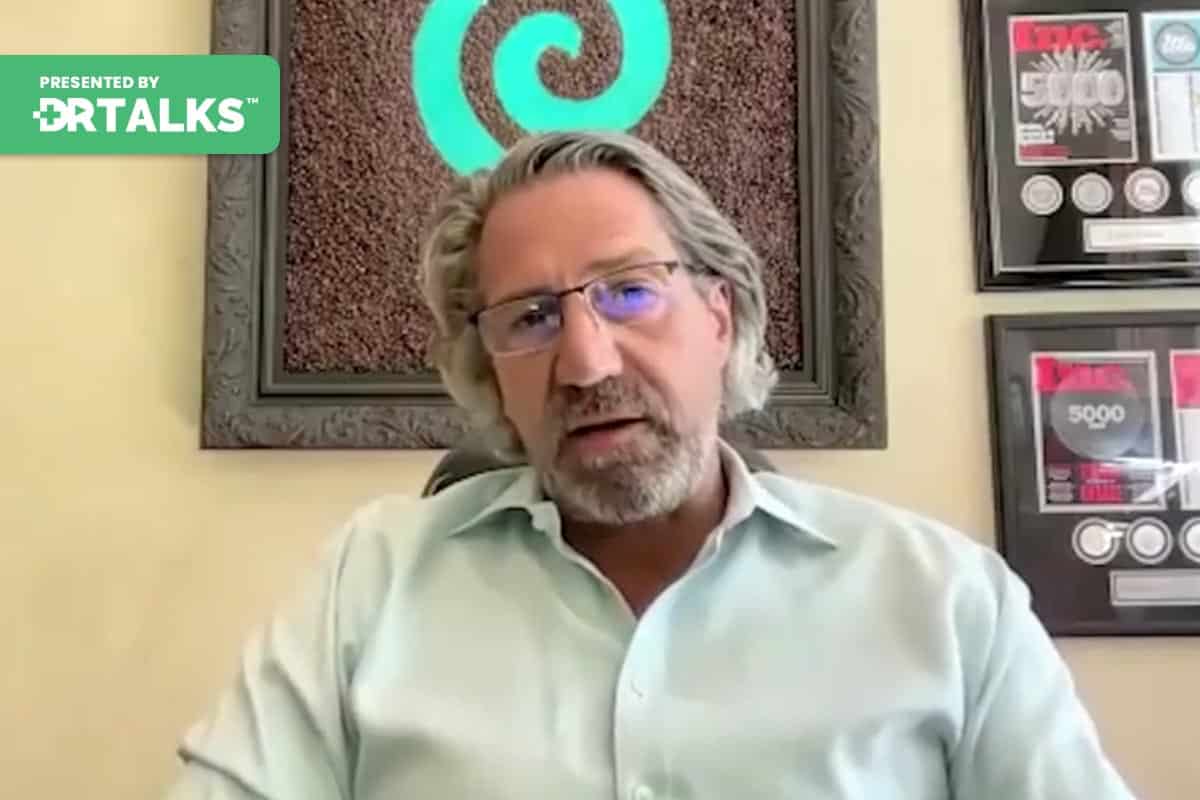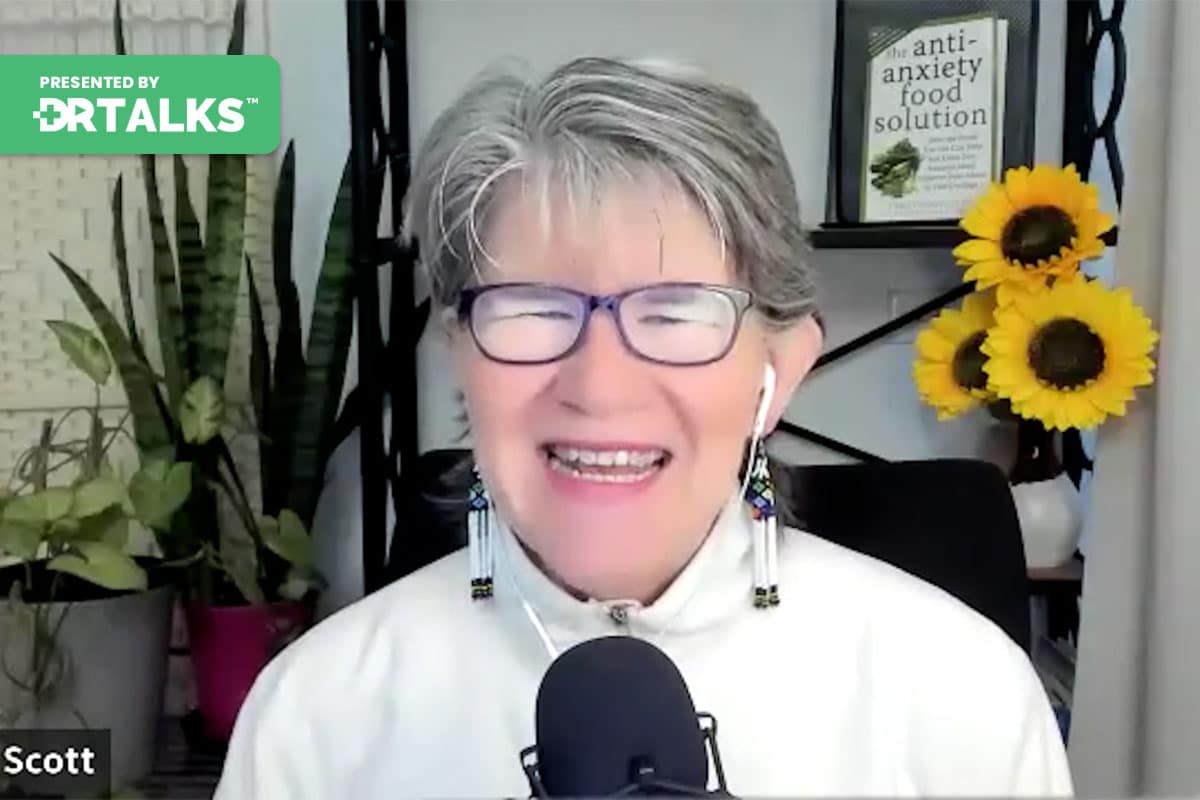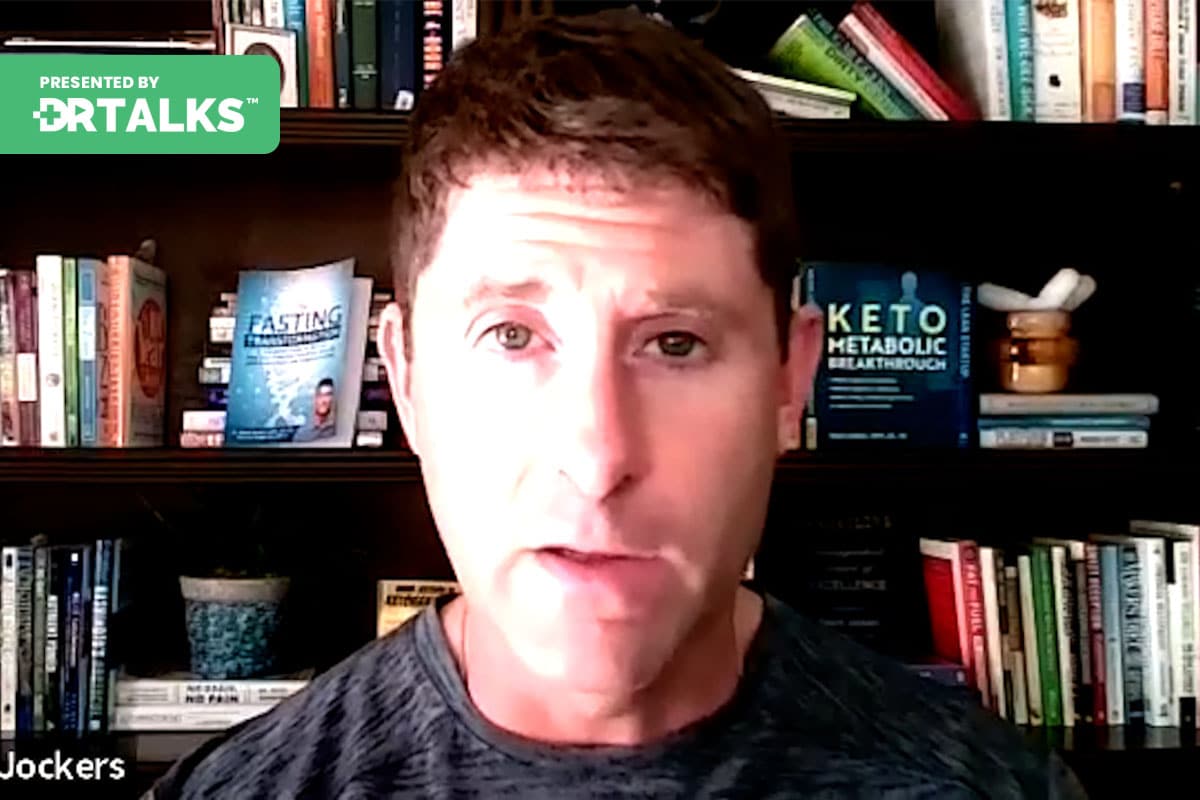Join the discussion below

Dr. Heather Sandison is the founder of Solcere Health Clinic and Marama, the first residential care facility for the elderly of its kind. At Solcere, Dr. Sandison and her team of doctors and health coaches focus primarily on supporting patients looking to optimize cognitive function, prevent mental decline, and reverse... Read More
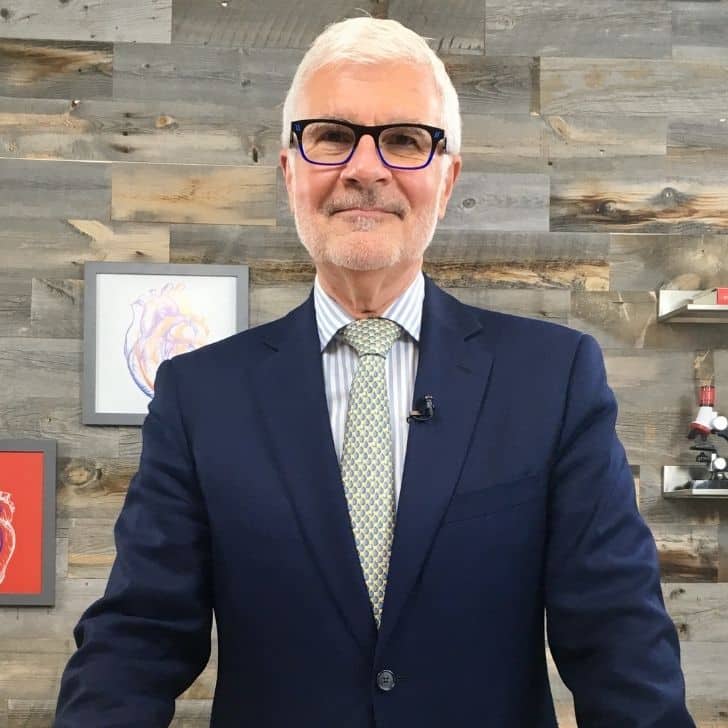
Steven Gundry, MD is a renowned heart surgeon, medical inventor, four-time New York Times best-selling author, and physician-scientist. Dr. Gundry is the leading expert on the lectin-free diet, as explained in his 2017 book, The Plant Paradox. He practices medicine six days a week at his wait-list-only clinics in Palm... Read More
Dr. Steven Gundry informs you about 5 things you can change in your diet to help reduce the risk of Alzheimer’s later in life
- Discover ways to reverse the symptoms of Alzheimer’s if they have already begun
- Learn about supplements that could help your memory and increase longevity
- Understand factors that put people at higher risk for Alzheimer’s
- Know the red flags you should look out for that indicate it might be time to see a doctor to talk about early-onset Alzheimer’s
Heather Sandison, ND
Welcome to this episode of the Reverse Alzheimer’s Summit. I am absolutely thrilled to be introducing you to Dr. Steven Gundry. You have probably already heard of him because he is a New York Times bestselling author, founder of Gundry M.D., and also one of the world’s top cardiothoracic surgeons. He is a mentor of mine. I certainly look to his books to get information and I have had the privilege of interviewing him once before and learned so much from just that one hour that we got to spend together. And I am absolutely thrilled that we are going to get to dive into some of the nuances around Alzheimer’s. He is at the forefront of some of the research around APOE and the risk factors associated with genetics. And he has also written a ton of books, The Longevity Paradox, The Plant Paradox, and The Energy Paradox. And so there are tons of resources that you can tap into because I know you are going to be excited about all that Dr. Gundry has to share today and want to learn more. Dr. Gundry, welcome.
Steven Gundry, MD
Well, thanks for having me. It is great to see you again.
Heather Sandison, ND
You as well. So I want to, if you do not mind, let’s just go straight into this APOE4r kind of conundrum here. There is so much research out there. Well, actually, maybe I shouldn’t say that. There is some research out there. I do not know if you are familiar with Becca Levy’s work where she showed that you can actually reduce the risk associated with APOE and Alzheimer’s just through mindset. And yet there are other risks in terms of lipid metabolism that we want to take very seriously. So dive into kind of your journey and expertise in that.
Steven Gundry, MD
Well, yeah, in my previous life, I guess I was a world-famous heart surgeon and I was fascinated as a heart surgeon that a lot of my patients carry the APOE4 gene. Either the single mutation or double mutation. And I thought it was curious why this would be a risk factor for them. There are certainly other genetic risk factors like carrying the gene to make Lipoprotein little (A), but that is in a way another story. Actually, it is not another story. A great number of people who carry the APOE4 gene carry Apo, the gene to make Lipoprotein little (A).
Heather Sandison, ND
I was just going to say, those are the people where I see LP little (A) elevated as in those APOE4 carriers.
Steven Gundry, MD
Yeah, it is not necessarily linked but clearly, I see a lot of people that have both and they in a way act in different ways but I think to quote or to channel Dale Bredesen, who has become a friend of mine through the years. There may be very good reasons for having APOE mutation and having, making LP little (A). So maybe we will go into that. So I got interested in why these people had this. And back in those dark ages, there was a lot of talk that lipid metabolism was somehow abnormal in people who carry the APOE mutation, four mutations. And so I approached my were looking from a cardiovascular standpoint. Okay. What is it about these guys and handling lipids that are so detrimental to them? Lo and behold, little did I know, or way back when that my now friend Dr. Dale Bredesen was approaching APOE4 from a neurologic standpoint and looking at Alzheimer’s. And now a number of years ago we were introduced at a conference where we were both speaking and both of us simultaneously.
I’m a big fan of yours. It is amazing what you have done and what. Me? No. So we have actually shared thoughts all along. And he and I have slightly different opinions, and my opinions have actually changed through the years. The longer I have been looking at this. And one of the things that I was absolutely positively convinced about 25 years ago when I started looking at this, was that saturated fats were really mischievous to APOE4 mutation folks. And I looked at that from a standpoint that, okay, if cholesterol transport, moving cholesterol in and out of cells is somehow wonky in people with APOE4 mutations, and there is some good evidence that is true. Then maybe one of the best ways to mitigate against these lipids moving the wrong way is to not have very many particles of LDL, particularly small dense particles of LDL. And there is some interesting research that suggests that is a pretty good idea. And so I spent a great deal of time looking to get these particles of LDL down in many people. It was clear from bloodwork that I do it every three months over people. That saturated fats particularly cheeses were mischievous to this profile, particularly in these people. And I would spend a great deal, admonishment of my patients to please get saturated fats out of your diet and that cheese was really kind of mischievous to you. And I kind of left it at that and spent many, many years saying saturated fat was the evil empire, particularly coconut oil was, It was real.
Heather Sandison, ND
Yeah, this is exactly what I want to talk about.
Steven Gundry, MD
Yeah. Coconut oil was one of the best ways I found to have people elevate their LDLs and actually even small particles of LDL. And believe it or not, I still think that. However, when I started to look into MCT oil which is medium chain triglycerides and one of the things may be from the start. So coconut oil, yes, has a lot of medium-chain triglycerides. And most medium-chain triglycerides are derived from coconut oil. The problem is that the major medium-chain triglyceride in coconut oil is C12. And C12 has absolutely no ketogenic effect, and maybe we will get into that in a little bit. And so if you actually look at the active C6, C8, and C10 in coconut oil, maybe only about 10% of coconut oil has the active ketogenic MCT. So coconut oil continues to say is not way up there on my list of fine foods for the treatment of Alzheimer’s or the prevention of Alzheimer’s. But MCTs are another study. I wrote my last book Unlocking the Keto Code about how MCTs work, not how everybody thinks they were but that is okay.
Heather Sandison, ND
Well, then let’s get at that misconception. How do they work?
Steven Gundry, MD
Alright. So MCTs are unlike any other fat. They are absorbed directly through the wall of our gut. All other fats, even olive oil or even coconut oil, whatever, have to be absorbed on carriers called Chylomicrons. And Chylomicrons literally are moving bands that pass through the gut wall and then do not enter the bloodstream. They enter the lymphatic system and the lymphatic system carries them up in the back of your chest and dumps them into the superior vena cava, where they then mix with blood. So it is a really roundabout process. MCTs on the other hand, are so tiny that they go right through the wall and they go to the liver where they are converted in general into ketone bodies, ketones. And it is kind of a do not pass go, do not collect $200, you pretty much have to convert MCTs into ketones. Now that is where it gets kind of interesting. And I have been a big fan of the ketogenic diet, actually since I started writing books. And even my ketogenic version of the plant paradox used MCT oil as really the foundation of it. But when you kind of start looking at the literature you go your ketones are the world’s greatest fuel. The brain loves ketones. The brain has to have ketones.
Well, sadly, that is a bunch of hogwash and it really is. And you can look at literature where you can look at other folks from Harvard and show that even at full ketosis in human volunteers. The body only gets 30% of its energy needs met by burning ketones. The vast majority of energy met needs matter for your fatty acids and some glucose. Free fatty acids, unfortunately, are too big to make it through the blood-brain barrier. The brain would be perfectly happy burning free fatty acids, and there is evidence that in fact, it would be very happy burning free fatty acids, just they can not get there fast enough. Ketones, on the other hand, can get through the blood-brain barrier and they can be burned as a fuel. Unfortunately, even at full ketosis, only about 60 to 70% of the brain’s needs are met by ketones. And you still got to have 30 to 40% glucose as fuel. Well, what about all those studies that show the brain lights up and everything and the PET scans and all this stuff? Well, it turns out that is no evidence that the brain is using these as fuel. What to that evidence is, and the argument I made in unlocking the keto code is that, guess what, mitochondria are being uncoupled by ketones. That is a signaling molecule and it is telling mitochondria to literally waste fuel and in the process of wasting fuel, they go through more fuel and it looks like they are using the fuel but they are not. Well, what does happen it turns out that when you uncouple mitochondria you make heat and neurons are really heat-sensitive. They love the heat. In fact, there is some evidence that they really want to be much hotter to work properly than any other cell in our body.
Heather Sandison, ND
Do we wear a hat or get in a sauna?
Steven Gundry, MD
Well, it may be that actually that is one of the benefits of a sauna. Sauna also uncouples mitochondria. We can get into that. So if so, anyhow, yeah, ketones are a great thing but not for the reason people think they are a great thing, it is to uncouple mitochondria. And quite frankly, if Alzheimer’s or any neurologic dementia is fundamentally a problem with mitochondrial function then getting your mitochondria to repair themselves to make more mitochondria, which is mitogenesis, to have damaged mitochondria self-eat mitophagy. And ketones can do that and then ketones are probably a really good idea as a part of a strategy. So when I was writing the energy paradox I was trying to explain how important ketones were in my poor knowledge of them. And the more I tried to explain it the more I realized, boy, everything that we in the ketogenic world think is right is wrong and that really smart person had already proved this wrong. We just did not want to look at the evidence. So that is when I really got into uncoupling mitochondria probably.
Heather Sandison, ND
This is a discussion of the mechanism and certainly from a clinical perspective and also from a personal perspective, my brain turns on when I’m in ketosis. And watching my patients their brains turn on. They improve their cognitive functioning and ketosis. So how is maybe what we are reconsidering? But are you questioning whether or not ketosis is the right diet and not forever. I do not, I’m not a proponent of having people in ketosis forever, but going in and out of ketosis is something that I recommend based on my clinical experience and the research we did in my clinic. Are you reconsidering that?
Steven Gundry, MD
No. We are supposed to go in and out of ketosis every 24 hours. And if we did this the way our ancestors did it, normally it takes us, if we have metabolic flexibility and let’s just define the terms we should. Any mitochondria should flip on a dime between using glucose as a fuel or we are using free fatty acids or ketones as a fuel, and we should be able to make that just like hybrid car switches. Unfortunately, we now know that 50% of normal-weight people have no metabolic input, and have no metabolic flexibility. 88% of overweight people have no metabolic flexibility and 99% of obese people have no metabolic flexibility. Normally, if we had metabolic flexibility about eight hours after we stop eating after our last meal we should begin making ketones. We should begin releasing free fatty acids from our fat cells. They should go to the liver, they should be converted to ketones. Ketones should then go to the brain and be a fuel source until the next morning or until breakfast to be a substrate for fuel. But what is really interesting and that is what should happen. What is really interesting is ketones rather than being a fuel source are actually signaling molecules for mitochondria to repair themselves to make more of themselves and that should happen during nighttime. And the longer you can keep that ketone signaling up to a point the longer that repair process goes on. So that is why I think people think now that time-restricted eating, particularly delaying break fast towards lunchtime and compressing your totally eating window to six to eight hours is a pretty doggone good idea not to bathe your brain in ketones, but to bathe your brain in ketones telling your mitochondria to repair themselves and make more of themselves.
Heather Sandison, ND
This is a bit of the concept, here is the hormetic effect.
Steven Gundry, MD
No. We thought it was hormesis. There is no such thing as hormesis. And I have written about hormesis so many times I’m embarrassed. That makes me strong. That is what does not kill me and makes me stronger. That is how we thought polyphenols work. That is how we thought resveratrol worked. Unfortunately, that is incorrect. All these hormetic substances work by uncoupling mitochondria. And once you realize that all of these things that we thought were hermetic. Hello, are you back again? Actually, work through the same process.
Heather Sandison, ND
Wow.
Steven Gundry, MD
And it is actually just one thing that all these substances do, and that is they uncouple mitochondria.
Heather Sandison, ND
Fascinating. And what about, you mentioned that there was, you are also getting rid of the old mitochondria that do not work as well. And so that stress on the system this is kind of what I was thinking is that hormetic effect in this example but no, that is not what is going on.
Steven Gundry, MD
No, it is not stressed on the system. This is actually, so ketones as well as polyphenols are signaling molecules to mitochondria. And the crazy thing is there is a professor, Dr. Brand in 2000, wrote an obscured little paper called Uncoupling to Survive. And he proposed that if you were starving to death then we know ketosis uncouples mitochondria. If you are starving to death then the last thing you have to preserve your mitochondria at all costs. Because if the mitochondria go, who cares? Who cares about your muscles? Who cares about your hair falling out? Who cares about anything else? Your mitochondria have to survive. And he proposed that under conditions of starvation, mitochondria would waste energy rather than actually rev themselves up and get every last little ounce of ATP, out of every little molecule in the body. And that sounds crazy. Wait a minute, If you are starving to death, why would you conserve? Yeah, why would not you? Well, he showed that in fact during starvation, mitochondria uncouple aggressively. I like to use an example, I’m using it in the next book, but I have done it on Podcast, so I’ll tell you now. So let’s suppose we have a dog sled and we have one dog. And the dog can pull the dog sled, and you are not going to go very fast and you are not going to go very far until the dog tires out. Imagine if we took five more dogs and hooked them to the dog sled. Each dog now would have to do six of the work of that individual dog and you would go a lot faster and you go a lot farther.
Only one problem, you now have to feed six dogs instead of one dog. So you need more food. And so what he showed was the process of stimulation of ketones makes your mitochondria aggressively uncouple, and that means wasted fuel. But it aggressively makes them, number one kill any mitochondria that look funny to eat itself, mitophagy, and recycle itself. And two simultaneously make more mitochondria, adding more dogs to the dog sled. And the really cool thing about mitochondria is they have their own DNA. And so they can divide separately from the cell divide. So you can easily add, I mean, they are quite frankly they are sometimes thousands of mitochondria in a cell. So you can easily add five more dogs to the dog’s sled so that each mitochondria has to do far much less work and protect itself. So making ATP is really damaging to mitochondria, reactive oxygen species, etc., etc… And so he said this is actually what should happen. Now he went on to show that if you look at long-lived people they have the most uncoupled mitochondria of anybody.
Heather Sandison, ND
Can I double-click on these uncoupled mitochondria? Because what I’m imagining is two mitochondria stuck together and then they are coming apart. So tell me what do uncoupling mitochondria mean?
Steven Gundry, MD
All right. So I wrote a book about this and unfortunately, I hate the word mitochondrial uncoupling. A lot of people think when I’m saying uncouple it is what stars do when they get divorced.
Heather Sandison, ND
Right. Imagining divorce.
Steven Gundry, MD
Well, so the object of the game in making ATP and we want more of your listeners is we want to couple protons with oxygen. And when a proton is coupled with oxygen in the electron transport chain in the inner mitochondria that coupled oxygen and ATP leave through a turnstile ATPA’s and generate ATP. And the electron transport chain is designed to energize electrons to produce enough energy motive force to pull protons into the inner mitochondrial membrane, have it meet up with oxygen, and then merry on. Go through the only way out through the electron transport chain which is a one-way door to a turnstile. Electrons can also couple with oxygen.
And we know that electrons coupling with oxygen are bad actors. Those are the reactive oxygen species. Those are why we have antioxidants in mitochondria and not to get too technical. There are only two antioxidants in the mitochondria, glutathione and get this melatonin.
Heather Sandison, ND
I thought you were going to say CoQ10.
Steven Gundry, MD
No CoQ10 is a co-carrier in the process of the electron transport chain. CoQ10 is kind of like a second baseman in a double play in baseball. The shortstop grabs the ball and throws it to the second baseman, the second baseman CoQ10 steps on the bag and throws it to the first baseman for the second out. So CoQ10 is an essential coenzyme to make the electron transport chain work. So and fun fact almost all adults do not make enough coenzyme Q10.
Heather Sandison, ND
And I want to talk to you about statins.
Steven Gundry, MD
Yeah. And statins prevent you from making CoQ10. Okay. So anyhow, back to coupling. It is nasty work generating ATP, and there is lots of damage. So and there is, I call it the Mito Club in my boo. It is the hottest place to be and everybody’s trying to couple and people are coupling with the wrong people. And a lot of times it gets hot and noisy, and beers are being thrown around. So there ought to be some emergency exits, too, when the heat gets overwhelming, when these reactive oxygen species are happening, there ought to be a way to slow down the process. Almost like a nuclear reactor and rods coming in. Well, it turns out that back in 1978, it was discovered that there were emergency exits in this electron transport chain, and they were controlled by uncoupling proteins. And they are five of them. And what they do is they release protons that normally would be trying to make ATP with oxygen out these back doors so that they never couple with oxygen. So oxidative phosphorylation is uncoupling oxygen and making ATP so that is an uncoupled mitochondria.
Now you go, well, that is a stupid idea. Well, not so fast. It turns out that you and I sitting here right now, 30% of everything that goes into our mitochondria to make ATP is uncoupled from the respiratory chain. We waste 30% of our energy, just the baseline, and you go, Boy, I had a really dumb design. Well, not so fast. It turns out that when we uncouple protons and oxygen we make heat, it generates heat. In fact, brown fat is brown because it has so many mitochondria that it looks brown under the microscope, and those are the most uncoupled mitochondria in us. And when you eat a thermogenic compound or eat a thermogenic diet. Little did I know that you are actually eating compounds that uncouple mitochondria and produce more heat. Getting back to the brain, if we uncouple the mitochondria and neurons, more heat is generated and our neurons work more efficiently even though they are making per mitochondria less energy but we have recruited lots more mitochondria.
Heather Sandison, ND
And is this the connection between Brown fat and cold exposure?
Steven Gundry, MD
Yeah. So they all work the same way.
Heather Sandison, ND
Okay.
Steven Gundry, MD
All work the exact same way. It is all uncoupling mitochondria. Yeah, I was a big researcher in heat shock proteins and heart rate. And so we learned this trick that we could cut off the flow of blood in an artery for about five minutes in heart surgery, and then literally give the heart a little baby heart attack and then we’d release it and let it reperfused for about 10 minutes. And if we did that and we found that we could then cut off the flow of blood to that area for an hour and the heart would be great. And it was discovered that there were these heat shock proteins that did it. Well, guess what? Heat shock proteins uncouple mitochondria. And that is how a sauna works. Sorry, folks. So it is that army since it is not that which makes me weaker makes me stronger. It is all this uncoupling process.
Now, let me give you the best example which my new PBS special will be out on March 1st called “Just one thing”. Birds. There is a theory that works quite well with longevity, basically the cost of living hypothesis. And that basically says the faster your metabolic rate the higher your metabolic rate the faster you are burning calories the shorter you live. And the slower your metabolic rate in general the longer you live. And that works for most things, a mouse is small and does not live very long and a human or an elephant is big and lives a long time. And it is true we have a lower metabolic rate compared to a mouse. Makes sense? The problem is birds. Birds are little and birds live an incredibly long time. A hummingbird in captivity can live 11 to 12 years and that thing has, its heartbeat is 1200 beats per minute and has one of the highest metabolic rates there is. A parrot can live 80 to 100 years. And when you look at birds’ mitochondria they have the most uncoupled mitochondria of any species.
Heather Sandison, ND
Fascinating.
Steven Gundry, MD
So since this is an Alzheimer’s talk, what you really want to do with all of what you do is you want to uncouple your mitochondria.
Heather Sandison, ND
All right. So how do we do it?
Steven Gundry, MD
Let’s get back to cheese, shall we?
Heather Sandison, ND
Cheese. I’m scared of what you are about to tell me because I love cheese.
Steven Gundry, MD
Good. And this was one of the things, like it or not, if I find out something new and that goes against what I preach and I think I teach rather than preach, I like to tell people I was wrong and tell them why I was wrong.
Heather Sandison, ND
Thank you. And good new information. And you are willing to change your mind?
Steven Gundry, MD
Yeah. I’m a teacher. I mean, I have spent my career as an academic teacher. Alright, so let’s find other compounds that might have medium-chain triglycerides. Now, that medium-chain triglyceride does seem to be a really good way of making ketones in your liver. And ketones seem to be a very useful way of uncoupling Mitochondria. It just so happens where the names for the various MCT carbons came from.
Heather Sandison, ND
It is the number of them, right?
Steven Gundry, MD
Well, yeah. Well, so there is caprylic acid.
Heather Sandison, ND
Right.
Steven Gundry, MD
There is Capric acid. Capra. Where have we heard that before? Well, it is the Latin word for goat, and C six, carbon six actually smells very goaty. And so it turns out that goat in sheep milk is 30% MCT oil. Interesting. Now cows milk and buffalo mozzarella, buffalo milk has the same thing. Fun fact, so as camel milk, plain old everyday milk does not. So you then look at long-lived societies and it turns out that the vast majority of these societies are goats and sheepherders. And they drink goat and sheep, figures they eat goat and sheep yogurt, they eat a lot of goat and sheep cheese. Just one example to prove.
Heather Sandison, ND
Is this like Blue Zones for example? Like longer lives.
Steven Gundry, MD
do not get me started on blue zones. They are not blue zones at all. If anything, they are white zones. So four of the five blue zones that Dan Buettner described, actually the main component of their diet that makes them different from all their other surrounding communities is that they are all goats and sheepherders.
Heather Sandison, ND
Fascinating.
Steven Gundry, MD
Just one quick example, Sardinia is one of the blue zones. Turns out that only part of Sardinia has longevity, and that is actually the mountainous region. The folks who live down by the ocean have no additional benefit. Why is there a difference? They all eat the same food except for one thing. The mountainous people eat goat cheese, they are herders. The folks down by the water do not. Let me give you another shocking example that probably Dr. Bredesen and I will have to shake our heads. There was a recent study out of Norway that actually made the news, and they looked at people with stable angina. Stable angina means you got coronary artery disease and when you exercise enough you begin to get chest pain. And if you stop it goes away.
And if you get pretty smart you go I probably do not want to walk that fast. And but it never really changes, never really worsens. And it is called stable angina. So they took a bunch of people with stable angina and they look at either their milk consumption, their butter consumption, or their cheese consumption. And they looked over the passage of time whose angina got worse or whose angina got better. And the big part of the paper was that dairy is really bad for coronary artery disease because the more dairy you drink, the more butter you eat, and the worse your angina gets. And it is very striking. You can watch the graphs, it is pretty fun. And then down at the bottom of this little abstract and it says, the only thing that is odd is cheese does not seem to have that effect. And then you go, well, that is interesting. So you dig up the paper and it is not only cheese, does not seem to have that effect. What the paper shows is the more milk you drink the worse your angina gets, and the more butter you eat, the worse your angina gets. But get this, the more cheese you eat, your angina goes down dramatically.
Heather Sandison, ND
Sweet relief.
Steven Gundry, MD
Perfect. So I actually to get back to how we started. I actually have my APOE4 folks eat goat and sheep products, virtually on a daily basis.
Heather Sandison, ND
Fascinating. Okay. So this was my million-dollar question for this interview. When I set up my clinical trial, it was in 2019, and I think Dr. Betersen and I both had kind of questions around ketosis and how into ketosis you need to get, and how restricted you need to be on dairy and meat products and other things that we consider inflammatory potentially if you are eating them all the time. And I went hard keto. I just said everybody keto regardless of APOE4 status let’s just, in our trial we are going to say go for it. And I’m not going to restrict. It is only six months, we will watch the lipid levels, we will get all the data, and it is a clinical trial, let’s see what happens. And sure enough, what we saw is that people with APOE4 four or three four are positive. We did not have any two four’s I think that is super rare.
Steven Gundry, MD
I see a ton of but the two cancel out before.
Heather Sandison, ND
Great. So they are good. I did not have any of those in the clinical trial. Yeah. But for everyone who got into ketosis who had APOE4, four or three four positive they all got better. They all had measurably. Now there were lots of other components. We did hormone replacement, we did diet and lifestyle stuff that organic ketogenic diet was primarily what we did for diet, but we increased exercise and we got them on supplements that many of which I’m sure you are familiar with. So we did much more than just the diet.
Steven Gundry, MD
Right.
Heather Sandison, ND
But that ketone level, anecdotally, the higher that ketone level, the bigger the delta in that measurable cognitive change. And so I have been dying to ask this question. Like I want people in ketosis because if their brain health is my primary objective, then I want to get them there and I do not want to be too restrictive. So what you are saying is I can add, we can certainly add the goat and sheep cheeses and maybe kefir and those kinds of things. And what we should be backing off of is the coconut and maybe saying restrict coconut oils.
Steven Gundry, MD
Yeah, absolutely.
Heather Sandison, ND
And butter, grass-fed butter as well.
Steven Gundry, MD
Throw it away.
Heather Sandison, ND
Okay.
Steven Gundry, MD
Yeah. And again, this study was very dramatic. That butter is just a disaster.
Heather Sandison, ND
Even grass-fed.
Steven Gundry, MD
Even grass-fed.
Heather Sandison, ND
Okay.
Steven Gundry, MD
It just has no benefit. There is a little bit of butyrate in butter but it is so infinitesimal, it is a waste of time for all the other mischievous things that butter causes. No offense. The other thing that is really exciting and I talk about it in the new book. The ketogenic diet was popularized as a seizure behavior in kids. And that is where it came from. And what is really exciting now, and I think I haven’t talked to Dale about this, what is really exciting is this some new information. It is animal studies but the effect of the ketogenic diet in preventing seizures or lessening seizures probably has nothing to do with ketones. It actually has to do with a change in the gut microbiome and it is the gut microbiome host biotics that is actually decreasing the seizures in kids.
Heather Sandison, ND
So I have a question. Sorry. What I understand. Do you think it is possible that all of these things that are happening, that it is not just using ketones for fuel? It is not just uncoupling of mitochondria, it is not just changing the gut microbiome, but it is all of them working together to enhance cell function.
Steven Gundry, MD
I do not know if your readers can see this. This was painted for me. The road to health is paved with good intestines.
Heather Sandison, ND
I love it.
Steven Gundry, MD
And you know, Hippocrates, 2500 years ago said all disease begins in the gut. The guy was right.
Heather Sandison, ND
Well, the gut starts in the mouth.
Steven Gundry, MD
So exactly. That is the gut. When you and I and Dale would agree with that. Yeah, the gut starts here and so the longer I have been at this, the more I realize then that this all comes from the gut. Amyloid comes from the gut, the signals for the brain to bite back on the dendritic processes come from sensing LPSs and other living bacteria that are escaping the gut wall, and the brain takes appropriate measures. The other thing that is exciting to me now is that we can measure leaky gut, we can measure leaky brain. We now know that the gut has a layer of mucus that protects against all this. It turns out blood vessels have a layer of mucus called the glycol calyx and son of a gun the blood-brain barrier has a glycol calyx. And the things that are exciting to me, starting as a heart surgeon that this glycol calyx is basically what has to be maintained in all of these systems. And it is just one fun thing for your listeners. You can light up the gut glycol calyx in any of these.
Heather Sandison, ND
In a good way.
Steven Gundry, MD
In a bad way.
Heather Sandison, ND
In a bad way.
Steven Gundry, MD
With wheat germ gluten.
Heather Sandison, ND
Right.
Steven Gundry, MD
And wheat germ gluten for those of you who care is in whole wheat products. And wheat germ gluten is an electron that is so tiny that it can actually pass through the wall of the gut with our leaky gut. And it just so happens it is a splinter and it attracts white blood cells to attack the glycol calyx of the blood vessels, it attacks the glycol calyx of the blood-brain barrier. And another fun fact is that it actually binds to the same sugar molecules in joints and causes arthritis. Hippocrates was right all disease begins in the gut.
Heather Sandison, ND
So do you recommend a gluten-free diet regardless of whether or not you are in ketosis?
Steven Gundry, MD
So gluten, believe it or not, gluten is probably the least mischievous of all of these compounds. And that may explain why most diets that use wheat take the whole off of wheat and get rid of it because that is where wheat German gluten is. Most people who eat rice as a staple take the whole off of rice because there is a wheat German gluten and like molecule in rice. Traditional cultures that use corn always treat corn with lye to make it into hominy because it was removing that gluten-like molecule of wheat German gluten molecule. And you start looking at traditional diets and you go, son of a gun. These guys were pretty doggone-smart. They did not know why they were doing it except they probably felt a lot better.
Heather Sandison, ND
There is a lot of wisdom. Yeah. It is nice. Amazing. Dr. Gundry, this is fascinating stuff. I want to make sure everyone knows how to find out more about you. I know you have got a podcast, of course, your books. And believe it or not, you still see patients. I know we share patients because we are both in Southern California.
Steven Gundry, MD
Yeah, six days a week. I see patients.
Heather Sandison, ND
So impressive.
Steven Gundry, MD
I mean, it is nuts. Why do I do it? Because this is the practice of medicine.
Heather Sandison, ND
How we learn.
Steven Gundry, MD
Yeah, and my patients have taught me so much by being the guinea pigs. Thank you, everybody. By, hey, let’s do this. Let’s take these supplements, you can get them at Costco or you can get them on Amazon or you can buy them from me at Gundry, M.D. But nobody, I do not even have any Gundry, M.D. products at my offices. That is not my object of the game. But let’s see what happens to you. Let’s see what happens to your blood work, and we can track this stuff. And I’m the original guy who said supplements made expensive urine, I firmly believe that. And when I watch the guy who changed my life big had to clean out his coronary arteries by changing his diet and taking some help from supplements from a health food store. I went, holy cow, how did the guy do that? I’m going to find out. And that is what changed my life.
Heather Sandison, ND
Well, you are the conventional medicine doctor who paid attention when somebody came in and said or showed you. You saw the difference in their labs and in their health in a measurable way. And you said, wait, I want to understand how you did this instead of kind of pooh-poohing it, which is a lot of the patients experienced that their dementia reversed and their neurologist says, no, they must have gotten the test wrong. And they are often made to feel it is just dismissed. So thank you for being the doctor that changed your life and your career and dedicated it to wellness and really serving.
Steven Gundry, MD
Well, okay. I see this all the time and they go, well, why and why does my doctor see this? Why did not they understand this? You can’t see unless your eyes are open. And luckily, I guess probably because I was a researcher. My eyes were open when I watched Big Ed Clean I was corner area and I go, well, that is not a placebo effect. It is like we reversed one of our old dogs’ inoperable bladder cancer with supplements. And that was not a placebo effect. Just here, let me put these things in your kibble and can you pee now? You are starting to pee and it is like, now it is gone.
Heather Sandison, ND
Wow. That is amazing. Yeah, there is no question when it works on kids and animals.
Steven Gundry, MD
That is right. That is right.
Heather Sandison, ND
You can’t fake it. So is it doctor gundrymd.com?
Steven Gundry, MD
So it is gundrymd.com is the Gundry supplement.
Heather Sandison, ND
Okay.
Steven Gundry, MD
drgundry.com is my website. We are just rolling out gundryhealth.com, which is going to be our telemedicine portal for people who can actually know. Particularly for autoimmune disease, and leaky gut, we can measure this at home with the blood test that people ship in. And we will have people that I have trained now to help people.
Heather Sandison, ND
Excellent. And you have got a podcast as well.
Steven Gundry, MD
Yeah. The Dr. Gundry podcast, wherever you get your Podcast. But I have offices in Palm Springs in Santa Barbara, and I just opened an office this week in Beverly Hills.
Heather Sandison, ND
Wow.
Steven Gundry, MD
So I see patients literally six days a week, and on the seventh day I do not rest, I go to Gundry M.D.
Heather Sandison, ND
That is a testament in and of itself that this medicine works because you live it and you have the energy to do all of these things and just take on superhuman tasks and a patient load.
Steven Gundry, MD
Right? Yeah, and again, I can’t resist it because I just, every day a bad choice of words but I’m a kid in a candy store because I really get to see miracles, what I would have thought were miracles. But I just get to see the workings of Hippocrates’ teaching. I mean, the guy knew this. And I was talking to David Perlmutter a while ago, and he and I were kind of talking. So it isn’t hilarious that a neurologist like you or Dale Bredesen, a cardiologist and heart surgeon like me, would all meet in the gut someplace that we really probably care less about in medical school. Yeah, that is really pretty funny, all we talk about is the gut now.
Heather Sandison, ND
Yeah, it is wild how transformative it is to see people get better and then follow what makes them better. Yeah. What happened? And how do we replicate that? How do we scale that? And I’m just so grateful that you are doing the work that you are doing. Spreading this word about how to create good health and what that means for the brain, for the heart, and for everything that matters. And thank you so, so much for your time today. It is just a sincere privilege to have some of it and to share it with our listeners, and I know that they are going to learn so much.
Steven Gundry, MD
Well, sorry to blow your mind with uncoupling mitochondria.
Heather Sandison, ND
I love it.
Steven Gundry, MD
It is really amazing how this is actually probably underpinning most of the good things that have happened to us. And the current book, “Unlocking the Keto Code” is actually a step-by-step. Okay, here is what to do if you want to uncouple your mitochondria, and here is why you.
Heather Sandison, ND
I’m going to order that right now because it hasn’t come out yet, has it?
Steven Gundry, MD
No, it is out.
Heather Sandison, ND
It is out? Okay. I do not know how I missed it. Well, I will order a copy right now.
Steven Gundry, MD
Yeah, try it. You’ll like it. You’ll go.
Heather Sandison, ND
And I will. Dr. Gundry, thank you so much. Have a wonderful weekend. And again, I could not be more grateful to have you here today.
Steven Gundry, MD
Well, thanks for having me. I appreciate it.
Downloads

